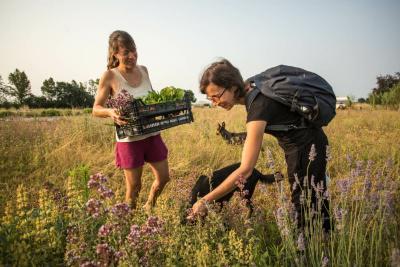‘The farms of tomorrow’ in Aveyron
Dialogue on local solutions for agriculture and food in the region
March 2025
In western Aveyron, agriculture and food are topics that are part of a regional project led by local stakeholders. They get together in workshops to find solutions to challenges that affect the whole farming sector, especially adapting to climate change and the socio-economic concerns of Aveyron’s farming industry, which is mainly focused on livestock.
A unifying regional food project
Since 2019, Ouest Aveyron Communauté has been bringing together a group of stakeholders around a Regional Food Project (PAT) to develop a comprehensive food policy that addresses economic, social, environmental and health issues. Working in tandem with Sarah Conquet, Sustainable Food Project Manager, Jules Bomare Lepape, Project Manager for Territorial Agricultural and Agri-Food System Transitions at Ouest Aveyron Communauté, coordinates the project: ‘The PAT is a cross-cutting project that includes actions on agricultural land and farm transfers, recruitment in the agri-food sector, the supply of local and sustainable products to collective catering services, consumer awareness, but also meat processing for short supply chains and access to quality food for the most disadvantaged. It is up to us to find the solutions that best suit our region and what we want to do with it.’
To support this project, Solagro and Ecozept carried out a quantitative regional assessment, analysing current trends in order to establish scenarios for the future of agriculture and food in the region. Workshops were organised to discuss these proposals with local stakeholders: farmers, associations, inter-professional organisations, the Chamber of Agriculture, the land development and rural settlement agency, agricultural colleges, citizens, elected officials, etc.

When the issues encountered were raised, many ideas emerged, particularly in response to the need to renew the farming generation, find buyers and transfer farms.
Amandine Delbès, administrator of the APABA (the Aveyron GAB) and organic farmer, highlighted the essential role of state structures and their responsibility in allocating authorisations to expand and operate, so that the agriculture promoted reflects the region and the desired food system.
Quality labels can also help to change local livestock farming practices. ‘The Interprofession Régionale du Veau d’Aveyron et du Ségala (Aveyron and Ségala Regional Veal Interprofessional Association), for example, requires in its specifications that farms have a minimum of 80% fodder autonomy and that animals graze outdoors for at least 180 days, in order to limit both inputs and costs,’ explains Aurélie Fayel, project manager for this label.
Payments for services provided by farmers
Farmers in Aveyron who practise non-intensive agriculture help to preserve the landscape, attract tourists to the area and, by maintaining their land, help to prevent fires. All these services could be remunerated.
Payments for environmental services (PES) already exist in France and make it possible to promote agricultural practices that help restore or maintain ecosystems from which society derives benefits (water quality preservation, carbon storage, landscape and biodiversity protection, etc.). They could be generalised and extended to western Aveyron.
The mobilisation of land can help to create a barrier against fires. For example, there are Pastoral Land Associations (AFP), particularly in the Causses du Quercy area. These structures bring together owners of forest plots to meet a dual objective: to comply with legal obligations to clear these plots by making them available for grazing sheep or goats. Farmers rent the plots they use, which allows young people to limit their investment costs when setting up.
Supported by the Aveyron Chamber of Agriculture, the ‘Bienvenue à la ferme’ (Welcome to the Farm) label on the agritourism website helps to link farms with tourism activities. A new complementary economic model, praised by Julien Hugonenc, a farmer in Aveyron, could be found.
Setting up as a collective
When it comes to young farmers setting up, the lack of capital, the complexity of technical skills and the difficulty of selling products at their true value, even in high-quality sectors, are all issues that have been hotly debated. In this context, the transition from a model based on family farms to a more collective model seems to offer many advantages.
It gives new generations the opportunity to join an existing structure without investing capital and to earn an immediate salary. Joining forces can also mean more free time, with the possibility of sharing working hours. The collective can also enable the pooling of tools and the integration of product processing workshops, bringing in new skills and sources of income while reducing the number of intermediaries.
Corinne Brigitte, director of the Lycée Beauregard in Villefranche, explains how the public agricultural college has developed a workshop for cutting meat products and processing fruit and vegetables into juices, compotes, jams, coulis, preserves, etc. This educational workshop also allows farmers to experiment with recipes and, why not, inspire them to integrate product processing into their farms to benefit from its added value.
Everyone agrees that processing workshops are an essential link in the economic and social fabric of the region. In Aveyron, as in all livestock farming areas, the viability of slaughterhouses is linked to that of the ‘Fermes d’élevage de demain’ (Farms of the Future).